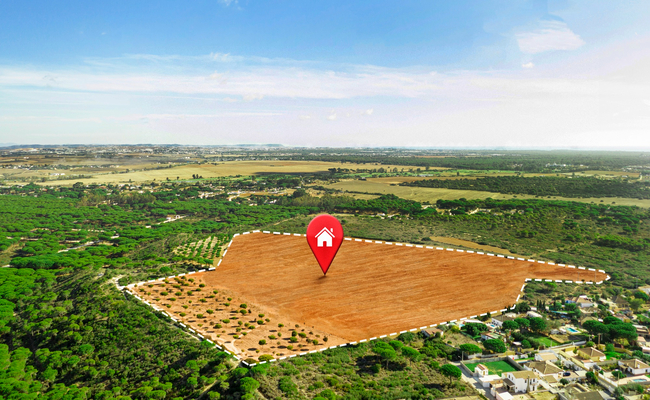Land development transforms raw property into thriving communities through strategic planning, proper permits, and expert guidance.
What is Land Development?
Land development transforms empty properties into useful spaces that benefit local communities. This process follows city rules and regulations to create areas that match your goals.
The main purpose is building spaces for housing, businesses, industries, or recreation. These developments meet the needs of people who live and work nearby.
Successful land development includes four key steps. First, conduct a detailed site review to find opportunities and potential problems. Second, create a design concept that puts your ideas on paper. Third, work with local planners to get required permits and approvals. Fourth, complete construction to make your plans real.
Each step requires careful planning and attention to detail. Following this process helps ensure your project succeeds and adds value to the community.
 Key Factors to Consider When Buying Land Today
Key Factors to Consider When Buying Land Today
Choosing the right land is the most important decision in your development project. Before moving forward, analyze the property carefully to ensure it matches your project needs.
Conduct a detailed review to confirm the site’s features work with your development plans. This step prevents costly mistakes and delays later in the process.
Successfully buying land requires examining several connected factors. First, research existing land use planning documents in the area. Second, verify that current zoning rules allow your intended use. Third, identify which permits you’ll need from different government agencies. Fourth, complete environmental investigations to avoid unexpected problems.
These steps protect your investment and increase your chances of project success. Taking time for proper research now saves money and headaches during development.
Land Use Planning
Land use planning involves working with property owners, developers, and local governments to approve projects. This collaborative process uses smart decision-making to guide development in your area.
The practice follows proven principles that promote organized growth. It also protects important open spaces and keeps developments consistent across regions.
The main goal is using land resources efficiently for all types of projects. This includes residential areas, businesses, and farming operations while considering social and environmental impacts.
Effective land use planning achieves several important objectives:
- Find the best options for using available land
- Review current local social and economic conditions thoroughly
- Evaluate development potential for both land and water resources on site
- Focus on efficiency, sustainability, and fairness throughout the entire planning process
This comprehensive approach helps create better communities while protecting natural resources for future generations.
Understanding the Planning Framework
The land use planning process helps determine where to place projects and how much land they need. This method works for economic policies, community plans, specific projects, and local programs. Planning includes analyzing all physical land conditions to ensure long-term project support. If development might create environmental problems, planners identify and solve these issues early. This proactive approach keeps land useful for future generations after development finishes.
Land use planning works at multiple government levels from local towns to international frameworks. Most plans start at the city level before connecting with higher government coordination. As available land becomes scarce and populations grow, planning becomes essential for cities. It helps prevent the harmful effects of unplanned development and random growth patterns. Proper planning protects communities from poorly designed projects that could damage the environment or reduce quality of life.
Strategic Advantages of Land Use Planning
Thoughtful land use planning provides many important benefits for communities and developers:
- Creates a strong framework for project development before construction begins
- Helps predict future area conditions so developers can build infrastructure that reduces risks
- Research shows strategic planning significantly improves urban economies
- Allows implementation of concrete steps to fight climate change challenges
- Advances environmental protection while conserving irreplaceable natural resources
- Restricts building in areas with high natural disaster risks
- Protects land from harmful transportation effects while reducing pollution and costs
- Significantly lowers public health and safety risks in local communities
- Prevents expensive land use conflicts from happening
These advantages make land use planning essential for successful development. Communities that plan ahead create better outcomes for residents and businesses while protecting the environment.
Zoning Basics
Zoning serves as an essential planning tool that cities use to control their built environment. It governs how land can be developed and defines what purposes each property can serve.
Cities maintain community health and safety by establishing detailed zoning requirements and classifications. These rules dictate which types of properties can exist together in specific areas or districts.
Different zoning classifications determine what each piece of land development can be used for in your development strategy. The most common classifications include:
- Residential – This classification allows construction of single-family homes, apartments, co-ops, and condominiums. Residential zoning laws also govern mobile home placement and regulate how many structures can be built on specific parcels. These zones often limit the types and quantities of animals allowed based on property size. Domestic pets typically remain unregulated, but farm animals are almost always prohibited in residential areas.
- Commercial – This versatile classification contains several categories based on business operations and expected customer volumes. Most real estate properties outside single-family lots receive commercial classification. Examples include shopping centers, hotels, certain warehouses, office buildings, nightclubs, and undeveloped land designated for these commercial purposes.
- Industrial – This specialized classification enables development of factories, manufacturing facilities, research institutes, and waste processing operations within designated areas.
- Agricultural – This classification permits active farming of fields, construction of agricultural silos, and building structures for livestock and farming vehicles. Development density stays minimal in these zones since most acreage remains dedicated to pasture and crop production activities.
Get the Right Permits
Navigating land use guidelines requires serious dedication and research. These important rules come from local government, state agencies, and zoning authorities in your area.
These regulations establish the framework for developing your property. You must understand all local standards and rules completely before making purchase decisions.
Land use permits function as your master blueprint for compliance. They ensure your development ideas follow every applicable regulation.
These permits examine how your project affects road infrastructure and traffic patterns. They also review population density targets, environmental limits, utility availability, stormwater control, commercial impacts, and public benefits.
Prepare for a comprehensive permitting process before securing your building permit. Your permit typically needs these essential components:
- State level access approvals, drainage systems, utility hookups, and solid waste disposal permits.
- Self serve fire suppression equipment plans.
- Wetland protection and conservation permitting.
- Coastal area design requirements and permitting procedures.
- Rivers, streams and floodplain management considerations.
- Environmentally sensitive zones, particularly forested areas requiring protection.
- Contaminated property assessment and cleanup plans.
- Open space allocation and preservation mandates.
- EPA’s Notice of Intent for Storm Water Discharges Associated with Construction Activity following NPDES General Permit guidelines.
Environmental Due Diligence
Overlooking environmental issues can severely limit or eliminate your building space on any site. Many promising projects have failed due to unexpected lawsuits, substantial fines, and costly cleanup requirements.
These problems happen because developers skip proper environmental due diligence upfront. Think of environmental due diligence as your proactive approach to managing environmental risks effectively.
It serves as your fundamental liability protection strategy. This process significantly reduces potential risks and prevents wasteful spending by identifying environmental liabilities before purchase.
You should investigate these critical environmental factors before committing to any land acquisition:
- Threatened and endangered species populations
- Jurisdictional waterways and wetlands classifications
- Protected natural areas and conservation zones
- Flood hazards and inundation risks
Skipping due diligence leaves you blind to environmental liabilities you could inherit with your purchase. Without comprehensive property examination, you might accidentally buy undevelopable land.
This includes illegally subdivided lots or parcels requiring numerous expensive workarounds that drain your budget and timeline.
 Land Planning Basics
Land Planning Basics
Project success starts the moment you begin planning your land development project with careful attention to detail. Planning mistakes can trigger serious environmental impacts while creating significant financial losses and unnecessary risks.
Bring together skilled land development engineering experts and knowledgeable environmental consultants for your project. Leverage powerful land development software tools to support your planning process.
This combination of expertise and technology equips you to choose and create the ideal land development plan. Proper planning sets your project up for long-term success from the very beginning.
Taking time to plan thoroughly prevents costly mistakes and environmental problems later in the development process.
Reliable Land Development Engineering
Bringing civil engineers onboard during initial planning phases determines whether your development project is truly feasible. These professionals assess raw land in its natural state to confirm it can support your planned development vision.
Civil engineers identify technical issues related to the property during this assessment. This includes topographic challenges, environmental constraints, and utility infrastructure limitations that could derail your project.
When engineers determine the land can support your planned development, they design your project’s complete infrastructure system. This includes laying out streets, planning utilities, establishing waste management solutions, and engineering drainage systems.
Engineers integrate essential systems by producing detailed drawings or using advanced modeling software to visualize their plans. Throughout this process, they must verify their proposed infrastructure plans comply with local zoning requirements.
Engineers also ensure plans avoid conflicts with existing municipal regulations before site plans enter jurisdictional review. This step is crucial for securing building permits and obtaining necessary zoning variances.
Expert Environmental Consultants
Your development success depends heavily on properly evaluating your property for potential problems that could stop your project. Environmental consultants blend scientific knowledge, regulatory expertise, and specialized experience to find and reduce risks.
These experts help you avoid legal action or expensive fines while ensuring compliance with all laws and regulations. They perform thorough desk research alongside essential fieldwork investigations on your property.
Environmental consultants deliver comprehensive reports that outline their findings and provide strategic recommendations for moving forward successfully. This professional guidance protects your investment and keeps your development project on the right track.
Working with qualified environmental experts early in the process prevents costly surprises and regulatory complications later in development.
 What to Expect During the Land Entitlement Process
What to Expect During the Land Entitlement Process
Land entitlement functions as the essential legal process for acquiring all approvals necessary to execute your development plan successfully. While the land entitlement process becomes prolonged, challenging, and costly, it remains vitally important.
Your project stays completely blocked unless you receive authorization from local regulatory agencies and acceptance from surrounding community members.
Through navigating land entitlement processes, several risks and challenges commonly arise:
- Any shortcomings in extensive environmental and technical studies can suspend project progress for months or years.
- Your project requires endorsement from numerous agencies including fire departments, utility providers, public transportation, and parks and recreation departments. These groups regularly identify concerns with proposed project specifications.
- New legislation could be enacted during your approval timeline that creates unexpected barriers to development goals.
- Your project could face various zoning or code violations that went unnoticed during past reviews.
- Final approval votes typically reside with City Council or board of supervisors. Since City Council members achieve positions through elections, they consistently evaluate planning department input and local community feedback before deciding. If your project contradicts political goals, lacks public benefit, or creates negative community impressions, securing City Council approval could represent your most difficult challenge.
Conclusion
Land development success requires careful planning, thorough research, and expert guidance throughout every phase of your project. Understanding zoning regulations, securing proper permits, and conducting environmental due diligence protects your investment from costly mistakes and delays.
Working with skilled civil engineers and environmental consultants ensures your project meets all regulatory requirements while maximizing development potential. These professionals identify potential issues early and create solutions that keep your project on track.
The land entitlement process may seem complex, but following proven strategies and maintaining community support leads to successful approvals. Start your planning early, gather the right team, and stay committed to following all local regulations.
Van Brunt & Company brings decades of experience to help you navigate every aspect of land development successfully. Our team is committed to guiding you through each step of the development process, from initial site assessment to final construction completion.
Frequently Asked Questions
- What is the first step in land development?
The first step involves conducting a detailed site assessment to identify opportunities and potential challenges. This includes reviewing zoning regulations, environmental conditions, and utility availability. Proper initial research prevents costly mistakes and delays later in the development process. Work with qualified professionals to ensure thorough evaluation of your chosen property. - How long does the land entitlement process typically take?
The land entitlement process usually takes 6 months to 2 years depending on project complexity. Simple residential projects move faster than complex commercial or industrial developments. Multiple agency approvals, environmental studies, and community input can extend timelines significantly. Plan for potential delays and maintain regular communication with all involved parties. - What permits do I need for land development?
Required permits vary by location but typically include building permits, environmental permits, and utility connection approvals. You may need wetland protection permits, stormwater management permits, and fire department approvals. State and federal permits apply for larger projects affecting waterways or endangered species. Consult local authorities early to identify all required permits for your specific project. - Why is environmental due diligence important?
Environmental due diligence identifies potential liabilities that could halt your project or create expensive cleanup costs. This process examines endangered species, wetlands, contamination, and flood risks on your property. Skipping this step can result in lawsuits, fines, and project delays costing millions. Early identification of environmental issues allows you to plan solutions or avoid problematic properties. - How much does land development cost?
Land development costs vary widely based on project size, location, and complexity of required infrastructure. Site preparation, utility installation, and permitting fees represent major expense categories for most projects. Environmental remediation, if needed, can significantly increase total costs beyond initial estimates. Obtain detailed cost estimates from qualified engineers and contractors before beginning any development project.

